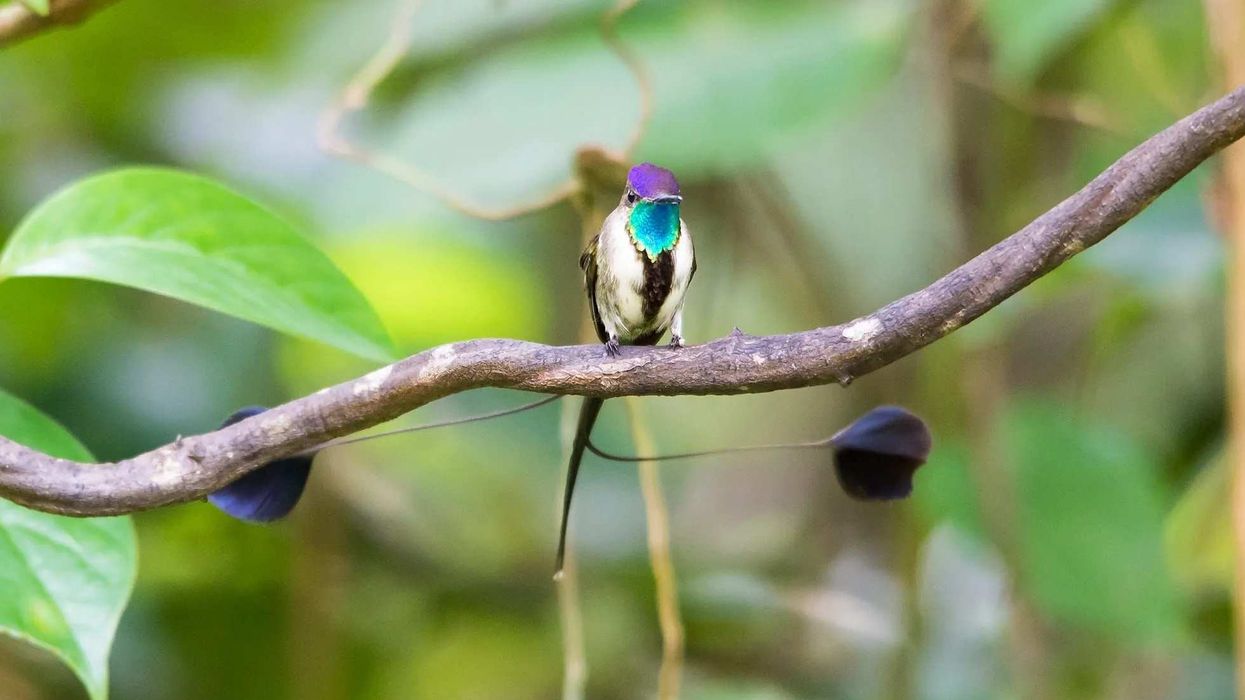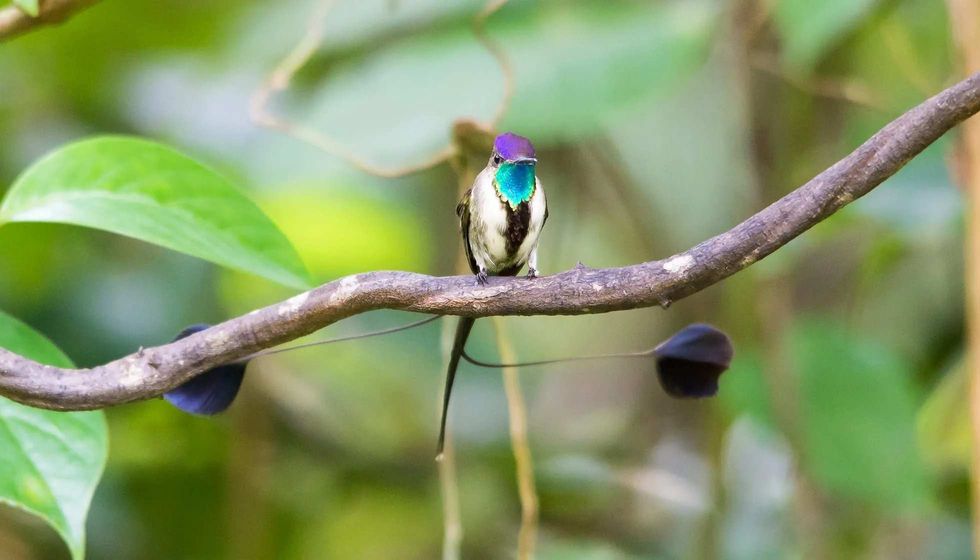The marvelous spatuletail (Loddigesia mirabilis) is a fantastic species of hummingbird that is native to Peru. Undoubtedly, it is the most fascinating of the humming species. As the name suggests, it sports a marvelous and spectacular exterior with fascinating colors in its body. With an average length of about 5.9-6.6 in (15-17 cm), it is a medium-sized bird.
A male marvelous spatuletail is more liked due to its blue crest feathers that adorn the head and a glistening turquoise patch at the throat area. The chest and abdomen are white with only a black line running down the center.
He has a long tail, unlike the females, whose tail is rather short and has drop-shaped rackets. The tail of a male species has four feathers that cross each other.
The tail feathers end at blue disc or spatules. This type of hummingbird can move this long tail on their own.
The tail feathers grow three to four times compared to the bird’s body in terms of length. You can find this extremely rare and endangered hummingbird species in northern Peru in the remote valley areas.
You'll find in this article information regarding marvellous spatuletail hummingbird blue discs or spatules, the marvellous spatuletail size, other hummingbird bird species, and why marvellous spatuletail live at forest edges.
For more relatable content, check out these bee hummingbird facts and great green macaw facts for kids.
Marvellous Spatuletail Interesting Facts
What type of animal is a marvellous spatuletail?
The marvellous spatuletail is a spectacular and rare hummingbird, whose occurrence is restricted to northern Peru in the Andean Cloud Forest. Another type of hummingbird is the rufous hummingbird.
What class of animal does a marvellous spatuletail belong to?
The marvellous spatuletail hummingbird owes its origin to the Trochilidae family.
How many marvellous spatuletails are there in the world?
This is an endangered species of hummingbird with a population ranging from 250-999 and a decreasing trend. They are rarely spotted within their restricted range. Deforestation is the primary cause behind the decrease in the number of these spectacular hummingbirds. Locals also pray for the male for its heart as it believed to contain aphrodisiac properties.
What is a marvellous spatuletail's habitat?
They live in northern Peru. This type of hummingbirds is mostly sighted along the eastern slopes of Rio Utcubamba Valley in the Cordillera del Colán, Amazonas. Marvellous spatuletails can rarely be seen at one spot in San Martin at a height of 7000 ft (2100).
What is their conservation status?
The occurrence of this hummingbird is restricted along the Rio Utcubamba Valley’s eastern slopes. They can also be seen in one particular site in northern Peru in San Martin, where they can be seen at an elevation of 7000 ft (2100).
Recent observations reveal that lately marvellous spatuletail hummingbirds can be seen around Florida, however their spotting is very less. This bird frequents forest edges, dense shrubbery, and second growth.
What is a marvellous spatuletail's habitat?
The marvellous spatuletail's habitat is around humid forest edges, dense shrubbery, and second growth. They forage over the edges of flowering shrubs and also favor thorny and impenetrable vegetation of Rubus thickets and Alnus trees.
Who do marvellous spatuletails live with?
After mating is done, female spatuletails live on their own. They build their nest and live there for incubation until the babies are born and ready to fly.
How long does a marvellous spatuletail live?
On average, marvellous spatuletail hummingbirds are known live for three to five years.
How do they reproduce?
The breeding season for marvellous spatuletails ranges from late October to early May. Males make use of their spatules to display at lek that the females visit to choose a mate.
The males try to attract the female by bouncing with speed back and forth along the horizontal twig mid-aid. He is said to perform this act almost 14 times within seven seconds. The male keeps hovering in front of the female while waving his spatules vigorously and making a chattering and snapping sound.
What is their conservation status?
This is an Endangered species as listed in IUCN Red List and the primary cause of this decline is deforestation. A lot of conservation has been initiated to protect marvellous spatuletail hummingbirds.
A conservation easement between the American Bird Conservancy and ECOAN is the first initiatives that aims to protect and manage almost 100 acres (40 ha) of habitat zone for this bird. Almost 30,000 trees and bushes have been planted to attract this bird. They are also working together to set up a viable eco-tourism program.
Marvellous Spatuletail Fun Facts
What do marvellous spatuletails look like?
The marvellous saptutail size is medium, with the males exhibiting beautifully striking colors and unique features. They have blue crest feathers on the head and their turquoise gorget looks amazing.
The chest and abdomen area is otherwise white with a black line running down the center. The tail of the male is very interesting and unique with four feathers in it.
Two of the tail feathers are shaped like racquets and end in large violet-blue spatules. The females lack the adornment of the males and come with a shorter tail and drop-shaped rackets tail feathers.
How cute are they?
These hummingbirds are extremely cute. A marvellous spatuletail hummingbird, especially the males, looks spectacular with its unique bodily features.
How do they communicate?
These hummingbirds communicate by making a humming sound and they also make flapping noises that are loud.
How big is a marvellous spatuletail?
A marvellous spatuletail is a medium-sized hummingbird that has a small body and long tail. Its beak is the size of a matchstick. It resembles a fluffy pino-pong ball.
How fast can a marvellous spatuletail fly?
They can fly very fast. They can cover 25 mph (40 kph) with their wings beating 50-200 times in a second.
How much does a marvellous spatuletail weigh?
This bird weighs around 0.006 lb (0.003 kg).
What are the male and female names of the species?
The males and the females of this hummingbird species are called marvellous spatuletail.
What would you call a baby marvellous spatuletail?
A baby marvellous spatuletail is called a chick or baby hummingbird.
What do they eat?
During the breeding season, they catch insects like small insects, worms, beetles, ants, aphids, gnats, mosquitoes, and wasps for protein. They mainly feed on nectar from scented and colorful flowers of trees, shrubs, herbs, and epiphytes. They can eat almost 10 times their body weight and these birds have one of the highest metabolism rate among all other animals.
Are they aggressive?
They are not aggressive.
Would they make a good pet?
Not really, they are born to be amidst nature and they are amazing fliers. They are meant to add to nature and keeping them within enclosed boundaries is not a good idea. Also, they feed on insects and nectar. Keeping them as a pet is not a possibility.
Did you know...
A marvellous spatuletail hummingbird’s heart beats 1200 times while in flight. The heart beats 200 times while they are resting. At night, they go for semi-hibernation when their heartbeat reduces to 50-180 beats per minute and also their body temperature decreases.
How did the marvellous spatuletail get its name?
You must be wondering from where it got its beautiful name. Loddigesia mirabilis, which is the scientific name for a marvellous spatuletail, is named after George Lodge.
Andrew Matthews, who was the first to report the genus in 1835 worked for George Loddige, which is why the scientific name is Loddigesia mirabilis. All credits for its charming name, marvellous spatuletail, go to its exquisite tail features and wonderful colors of the bird’s body.
The male species are celebrated among birds owing to their long tail, attractive turquoise throat patch, and blue crown on their head.
There are four feathers in the tail, with the two outer ones shaped as spatules. The bird, also known as the star bird of Peru, is named after its gorgeousness.
Where to spot the marvellous spatuletail?
As per the latest updates, the best place where these birds can be found is Huembo near Pomacocha in Peru. They can also be spotted at Kentitambo in Leimebamba, which is nearby Kuelap and Gocta waterfalls.
The best time when the chances of spotting an active marvellous spatuletail is high is between November to June. If you are lucky enough, you may end up spotting a male spatuletail (Loddigesia mirabilis).
Here at Kidadl, we have carefully created lots of interesting family-friendly animal facts for everyone to discover! Learn more about some other birds from our summer tanager facts and cardinal bird facts pages.
You can even occupy yourself at home by coloring in one of our free printable marvellous spatuletail coloring pages.









